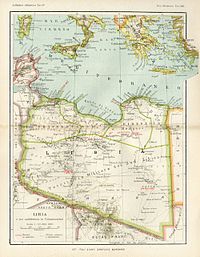Aouzou Strip

The Aouzou Strip (
Inclusion in Italian Libya

The Aouzou strip was defined for the first time in the discussions between France and Italy after
After many discussions during the 1920s, in 1935 the
This policy failed two years later after Italy drifted into the German orbit by concluding the Pact of Steel with Nazi Germany, leading to the "instruments of ratification" of the Mussolini-Laval Treaty never being exchanged with France.[1] Despite this, the new border was conventionally assumed to be the southern boundary of Libya until 1955.[1]
History
Claimed to be rich in
Libya argued that the territory, as part of the Borderlands, was inhabited by indigenous people who owed vassalage to the
The frontier claimed by the Chadian government was based on a 1955 treaty between France and Libya, which, in turn, referred back to an 1899 agreement between Great Britain and France about "spheres of influence." Despite other differences, this was one position on which all Chadian political parties and factions were able to agree.
The United Nations Security Council established the United Nations Aouzou Strip Observer Group in Resolution 915 (May 1994) to monitor the withdrawal of Libyan troops, and terminated it in Resolution 926 (June 1994), when the withdrawal was completed.
See also
References
- ^ a b c d Hodder, Lloyd, McLachlan (1998). Land-locked states of Africa and Asia, Volume 2, p. 32. Frank Cass, London, Great Britain.
- US State Department). April 10, 2002.
- ^ ISSN 0309-0671.
- ^ Robert W. McKoeon (1991). "The Aouzou Strip: Adjudication of Competing Territorial Claims in Africa by the International Court of Justice". Case Western Reserve Journal of International Law, Vol. 23, Issue 1. pp. 147–170. Retrieved 25 October 2020.
External links
- Territorial Dispute (Libyan Arab Jamahiriya/Chad) – The case documents on ICJ website
- Frank Jacobs: Borderlines: The World's Largest Sandbox, The New York Times / The Opinion Pages on November 7, 2011

